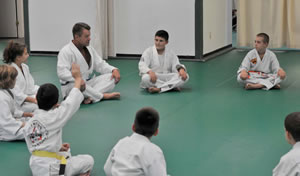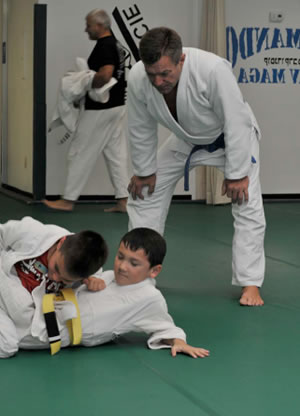Bullying

PHOTO COURTESTY OF HERB DRILL
The onus for burgeoning bullying and “bullycide” belongs on everyone’s shoulders. Perhaps part of the perplexing, perilous issues reverts to parents, who don’t act and/or react sooner. Possibly, one out-of-school solution is the Eastern philosophy of martial arts.
Kids get bullied at school for their appearance, academic ability, hobbies, disability or being the new kids. It’s said bullying flourishes in schools when the audience of bystanders is silent. Proactive anti-bullying programs seem more likely to stop bullies, but not every school is committed to stopping the abuse.
Many gifted children are intense, sensitive and stressed by their own and others’ expectations. They may be vulnerable due to ability, interests and behavior; social justice issues are vital, as they try to grasp cruelty and aggressive acts.
Retired Philadelphia high school science teacher, Mel Flitter, argues charges that “rarely” are teachers consulted; “rather, professors at universities who read each other’s research are quoted and they’ve never been in an inner-city classroom; they went to private and Ivy League schools.” He adds, people have to be taught to share, cooperate. How? CONSEQUENCES!”
The National Education Association figures 160,000 children miss school daily due to fear of or intimidation by a bully. Worse, only 15 percent report it. CNN’s Anderson Cooper AC 360° investigated teen suicides due to bullying despite new state laws, countless experts’ opinions and the media’s glare. Cooper found, it’s left to schools to enact reform. They’re given few solutions, only vague orders to implement anti-bullying programs.
DO PEOPLE UNDERSTAND WHAT CAUSES KIDS TO BULLY?
Cooper and University of California sociologists found the stereotypical schoolyard bully preying on the weak doesn’t begin to reflect reality. Instead, they liken high schools to social combat, where students are trying to fight to top the social hierarchy. For a CNN special report, Katia Hetter wrote that working with children early can help a child develop self-confidence, encourage courageous behavior and help “bully-proof” them.
In Deptford, N.J., a teacher faced discipline after being recorded telling a special needs student that he was a “tard” and responding sarcastically to the student’s pleas not to be called “special.” The Huffington Post reported Gloucester County Special Services District board reviewed the student’s accusations of harassment, intimidation and bullying and placed the teacher on paid administrative leave. The parents told ABCNews.com that their 15-year-old son, — with attention deficit/hyperactivity disorder and emotional issues — had been bullied before by the teacher. They urged him to record video on his cell phone if the instructor did it again.
As captured secretly on his cell phone, the Philadelphia Inquirer reported, the boy is cursed and berated by a man who’s supposedly a mentor. His teacher says, “I will kick your [expletive] from here to kingdom come until I’m 80 years old. What are you going to do? You gonna get a chopper and chop me?” asks his teacher. The student showed his taped account to his parents and a local advocate of bullied students.
Brenda High knew bullying first-hand to write “Jared’s Story.” Brenda, co-founder and a director of the Bully Police USA watchdog advocates, recalls her son was 12 when older students at his middle school bullied him. Jared had a learning disability and was a slow reader. A well-known bully assaulted Jared in the gym. Then, Jared displayed depression, lack of sleep and emotional outbursts. On Sept. 29, 1998, Jared called his father at work to say “good-bye” — and shot himself. For healing, Brenda has been on a mission to stop school bullying and peer abuse. She stresses the emotional and physical dangers of bullying, which can lead to bullycide — a suicide after bullying.
Global motivational speaker/life coach, Scott Chesney, wants parents to identify what role they play in kids’ school and in their lives. “Every role is related to self-esteem. We should all want to be leaders... not bullies, not victims, not witnesses,” he says. Help kids realize, “bullying is unacceptable. Take responsibility for your role and your child’s role in bullying,” he adds.
What’s missing, argues Jacksonville, Fla.’s Daryl Brown, is Gracie Jiu-Jitsu. At Champion Martial Arts & Fitness, Daryl has 20-plus years experience as a Krav Maga, children’s life skills and children’s Jiu-Jitsu instructor. His wife, Kim, is a certified personal fitness trainer; women’s Krav Maga instructor and certified in CPR/first aid.
They explain: In the 1920s, Helio Gracie created Gracie Jiu-Jitsu after he realized he was too small for traditional Japanese techniques. Reliable for someone to overcome a larger, more athletic antagonist, Gracie Jiu-Jitsu features precise timing/effective leverage. Gracie studies found 36 of 600-plus techniques are used more often, with greater success.
 Daryl contends Gracie Bullyproof “shapes character [and] confidence.” Classes spotlight a character trait”and simple things a child can do in their lives. Traits Include responsibility, health, respect, manners and caring. The system tracks a child’s points for a chosen trait improvement. If it’s responsibility, he/she can earn points for homework done or a clean room.
Daryl contends Gracie Bullyproof “shapes character [and] confidence.” Classes spotlight a character trait”and simple things a child can do in their lives. Traits Include responsibility, health, respect, manners and caring. The system tracks a child’s points for a chosen trait improvement. If it’s responsibility, he/she can earn points for homework done or a clean room.
“Bullies, predators by nature, prefer the weak as prey,” argues triple-black-belt-holder Kris Wilder, a Franciscan monk and co-author of How to Win a Fight. A confident child is “less likely to be a victim;” martial arts provides this “platform for creating a resilient, confident child. Some kids benefit having a sense of their physical strength via martial arts or other discipline. Martial arts creates an immediate, indelible link to the internal sense of a child’s being via external drills and discipline,” says Wilder, operator of West Seattle Karate Academy. “This makes a child more confident, (which) carries over into how a kid holds himself in the world. “
Brown agrees, and claims Gracie Bullyproof character development is unique, because, “we develop a child’s character [and] their confidence.” At each class, “we dedicate a few minutes to discussing a featured character trait and the simple things a child can do to make it part of their everyday lives.” The secret to success is an incentive-based point system designed to keep a child excited about making daily progress. As a child progresses through the curriculum, he/she is awarded belts in line with the Gracie ranking system. A certified Bullyproof belt holders list is at www.GracieKids.com; when a child earns their white-yellow belt, their name hits the list.
Even after learning self-defense techniques, there’s a very good chance a child won’t take a stand against bullies — fear of punishment from school administrators and parents. By teaching the Rules of Engagement, “you give them a step-by-step plan for any time they’re targeted. You’ll give them assurance you’ll support them [if] compelled to stand up for themselves. Their goal, if they get into a fight, is to control the bully and gain cooperation without causing any unnecessary harm,” says Brown.
Basic rules are essential to use the techniques:
- Avoid the fight at all costs.
- If physically attacked, defend yourself.
- Never punch or kick the bully, establish control and negotiate.
- When applying submissions, use minimal force and negotiate.
Brown adds, “The best way to show a child you support Rules of Engagement is to have casual conversations with them. The goal is to make it clear that if they’re getting bullied, they have your permission to follow the appropriate steps and take a stand against the bully.”
Brown and Kim emphasize, “We don’t teach jiu-jitsu; we play jiu-jitsu! We’ve devised 10 Gracie Games where we secretly teach essential self-defense. Children develop strong reflexes in [doing] basic techniques and learn, unconsciously, principles of leverage and control. Since bullying is most prevalent in the eight- to 14 year-old age group, we teach children in [that] class techniques they must know to defend themselves. The best part is they’re all non-violent control tactics to minimize injury to the bully if used during a real fight.”
Brown and Kim state that with basic Gracie techniques, a child is set to deal with a bully — it instills self-confidence — even for a disabled child. The only way a child will stand up against a bully is if they’re confident they can defend themselves if they’re victimized, they say. “With Gracie, a child learns highly-effective techniques that don’t rely on punches or kicks. They take a stand — without violence,” they add.
This article originally appeared in the School Planning & Management July 2013 issue of Spaces4Learning.